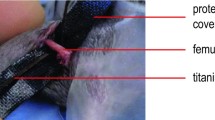Abstract
Background
Revascularization of a fracture depends on fracture stability and fracture gap conditions. The aim of the study was to determine quantitatively the revascularization and tissue differentiation in an animal model with different fracture gaps and controlled biomechanical conditions.
Materials and method
The study was performed on ten sheep with an osteotomy on the right metatarsal. The fracture was stabilized by an external fixator that allowed adjustable axial interfragmentary movement. Two groups of five sheep each were adjusted to a medium sized gap (M, 2.1 mm) and a large gap (L, 5.7 mm) under comparable interfragmentary strain (30–32%). The animals were killed after 9 weeks, and the metatarsals were prepared for undecalcified histology and analysis of tissue differentiation and vessel distribution.
Results
Group M showed significantly more revascularization (M=1.62, L=0.85 vessels/mm2), more bone formation (M=37.2%, L=13.9%) and less fibrocartilage tissue (M=18.1%, L=39.1%) than group L. Larger vessels (>40 μm) were found mainly in the medullary channel, and smaller vessels (<20 μm) mainly in the peripheral callus. Histologically, group M showed partial bony bridging of the osteotomy gap, and the group L had delayed healing.
Conclusion
A good reduction of a fracture with small interfragmentary gaps is important for its revascularization and healing.







Similar content being viewed by others
References
Augat P, Margevicius K, Simon J, Wolf S, Suger G, Claes L (1998) Influence of size and stability of the osteotomy gap. J Orthop Res 16:475–481
Claes L, Augat P, Suger G, Wilke HJ (1997) Influence of size and stability of the osteotomy gap on the success of fracture healing. J Orthop Res 15:577–584
Markel MD, Bozdanske JJ (1994) The effect of increasing gap width on localized densitometric changes within tibial osteotomies in a canine model. Calcif Tissue Int 54:155–159
Claes L, Grass R, Schmickal T, Kisse B, Eggers C, Gerngross H, Mutschler W, Arand M, Wintermeyer T, Wentzensen A (2002) Monitoring and healing analysis of 100 tibial fractures. Langenbecks Arch Surg 387:146–152
Müller J, Schenk R, Willenegger H (1968) Experimentelle Untersuchungen über die Entstehung reaktiver Pseudarthrosen am Hunderadius. Helv Chir Acta 35:301–308
Eitel F (1996) Revaskularisierung langer Röhrenknochen nach Fraktur und Osteosynthese. In: Kuner EH (ed) Stabile Osteosynthese. Thieme, Stuttgart New York
Rhinelander FW (1974) Tibial blood supply in relation to fracture healing. Clin Orthop 105:34–81
Claes L, Eckert-Hübner K, Augat P (2002) The effect of mechanical stability on local vascularisation and tissue differentiation in callus healing. J Orthop Res 20:1099–1105
Claes LE, Heigele CA, Neidlinger-Wilke C, Kaspar D, Seidl W, Margevicius KJ, Augat P (1998) Effects of mechanical factors on the fracture healing process. Clin Orthop 355S:132–147
Claes LE, Heigele CA (1999) Magnitudes of local stress and strain along bony surfaces predict the course and type of fracture healing. J Biomech 32:255–266
Schweiberer L, Schenk R (1977) Histomorphologie und Vaskularisation der sekundären Knochenbruchheilung unter besonderer Berücksichtigung der Tibiaschaftfraktur. Unfallheilkunde 80:275–286
Carter DR, Blenman PR, Beaupre GS (1988) Correlations between mechanical stress history and tissue differentiation in initial fracture healing. J Orthop Res 6:736–748
Carter DR, Beaupré GS, Giori NJ, Helms DDS (1998) Mechanobiology of skeletal regeneration. Clin Orthop 355S:41–55
Acknowledgement
This study was kindly supported by the German Research Council (DFG-Cl 77/2).
Author information
Authors and Affiliations
Corresponding author
Rights and permissions
About this article
Cite this article
Claes, L., Eckert-Hübner, K. & Augat, P. The fracture gap size influences the local vascularization and tissue differentiation in callus healing. Langenbecks Arch Surg 388, 316–322 (2003). https://doi.org/10.1007/s00423-003-0396-0
Received:
Accepted:
Published:
Issue Date:
DOI: https://doi.org/10.1007/s00423-003-0396-0




